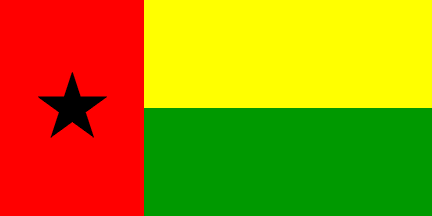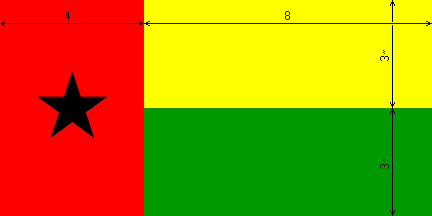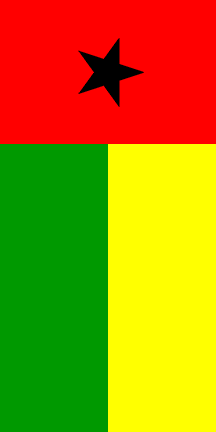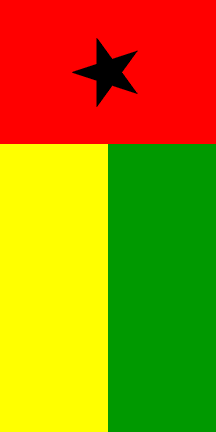 image by Zoltan Horvath, 9 June 2024
image by Zoltan Horvath, 9 June 2024
Last modified: 2024-11-09 by rob raeside
Keywords: guinea bissau |
Links: FOTW homepage |
search |
disclaimer and copyright |
write us |
mirrors
 image by Zoltan Horvath, 9 June 2024
image by Zoltan Horvath, 9 June 2024
See also:
Yellow over green bicolour with red vertical stripe at hoist
containing a black five-pointed star.
Željko Heimer, 23 Oct 2001
The symbolism of this flag is inherited from the symbolism of
Ghana, from which it comes: an arrangement
of the pan-African colours with the
black star of Africa added.
Its proportions are, as in the party
flag, 1:2.
Jorge Candeias, 02 Nov 1999
 image by Željko Heimer, 23 Oct 2001
image by Željko Heimer, 23 Oct 2001
The Album 2000 [pay00] says ![]() ≅1:2.
The construction details are given, but since the overall ratio is
approximate, the construction details are inevitably so. The two
horizontal stripes are of the same size, of course, and the width of
the vertical stripe is one third of the total length.
The star appears to be inscribed in a circle with the center in the
midpoint of the red stripe and of diameter equal to two units used on
the scheme (i.e. 1/3 of hoist).
≅1:2.
The construction details are given, but since the overall ratio is
approximate, the construction details are inevitably so. The two
horizontal stripes are of the same size, of course, and the width of
the vertical stripe is one third of the total length.
The star appears to be inscribed in a circle with the center in the
midpoint of the red stripe and of diameter equal to two units used on
the scheme (i.e. 1/3 of hoist).
Željko Heimer, 23 Oct 2001
I read somewhere in the 1st constitution of Guinea Bissau (or maybe in
the Statutes of P.A.I.G.C.) that the three
areas of the flag are to have the same area, saying nothing about the
final ratio of the flag — therefore a, say,
2:3 ratio might be not really a mistaken
depiction.
António Martins, 26 Jul 2009
The protocol manual for the London 2012 Olympics
[loc12], with info approved by
each NOC, gives for Guinea-Bissau PMS 032 red,
109 yellow, 355 green and black.
Ian Sumner, 11 October 2012
I should say that some of these colors seem to me to be just too dark:
PMS 032, for one, is British red, which is known to
be darker than regular red, while PMS 109 is suitable for the national
flag of Germany, knowingly “darker” than
regular yellow. The green stripe of the national flag of Guinea-Bissau is
noticeably brighter than the the green areas of the national flags of
Brazil and Portugal (these
three flags are easy to find flown along in coherent displays), which are
known to be prescribed as dark green — so, PMS 355 seems okay.
António Martins, 20 March 2017
The Presidency website has a page about national symbols with illustrations:
https://www.presidencia.gw/sobre-a-guin%C3%A9-bissau-1
I haven’t found
any governmental document about exact shade of colors.
Zoltan Horvath,
9 June 2024
Other sources for colors:
There is no official source that gives exact
colors of the national flag; these are all approximate colors from these
documented sources.
The Flag Manual - Beijing 2008 gives Pantone colors:
PMS 032 (red), PMS 355 (green), PMS 102 (yellow), and PMS Black.
The
Album des Pavillons 2000 [pay00] gives
approximate color in Pantone and CMYK systems:
Red: Pantone 186c, CMYK
0-90-80-5
Yellow: Pantone 116c, CMYK 0-15-95-0
Green: Pantone 355c, CMYK
100-0-90-0
The Album des Pavillons 2023 already specifies the color of
the flags in three color systems.
Red: Pantone 186c, CMYK 14-100-79-4, RGB
200-16-46
Yellow: Pantone 116c, CMYK 0-21-93-0, RGB 255-204-0
Green:
Pantone 355c, CMYK 84-12-100-1, RGB 0-149-48
Vexilla Mundi gives colors in
Pantone system: PMS 116C (yellow), PMS 355C (green), PMS 186C (red), and PMS
Black.
Wikipedia gives color values as
follows:
Black: Pantone Black c, CMYK 0-0-0-1, RGB
0-0-0, Hex #000000
Red: Pantone 032c, CMYK 0-0.92-0.82-0.19, RGB
206-17-38, Hex #CE1126
Yellow: Pantone 109c, CMYK 0-0.17-0.91-0.01, RGB
252-209-22, Hex #FCD116
Green: Pantone 355c, CMYK 1-0-0.54-0.38, RGB
0-158-73, Hex #009E49
Flag Color Codes gives the following color values:
Red: Hex. # EF3340, RGB 239-51-64, CMYK 0-90-76-0, Pantone 032, RAL 3024
Yellow: Hex. # FFD100, RGB 255-209-0, CMYK 0-5-100-0, Pantone 109, RAL 2007
Green: Hex. # 009739, RGB 0-151-57, CMYK 93-0-100-0, Pantone 355, RAL 6037
Black: Hex. # 000000, RGB 0-0-0, CMYK 0-0-0-100, Pantone Black, RAL 9005
Zoltan Horvath, 9 June 2024
The Independence of Guinea Bissau was proclaimed by the National Assembly,
which was basically appointed by the Partido Africano para a Independência da
Guiné e Cabo-Verde (PAIGC), the independence party which not only fought for
independence from Portugal for Guinea Bissau from Portugal, but also for Cape
Verde (Cabo Verde).
The same day [23 September 1973] as the proclamation
of independence, the National Assembly proclaimed the (first) Constitution of
the Republic of Guinea Bissau. It was published in the very first edition of the
Boletim official República da Guiné-Bissau, (Government Gazette), of 4 January
1975. Chapter 1, Article 2 describes the flag and other symbols as follows:
Constituição da República da Guiné-Bissau
Capítulo 1 Dos fundamentos o
objectivos
Artigo 2º: A Bandeira Nacional da Guiné-Bissau é constituída por
três bandas com a mesma superfície, sendo uma vermelha disposta verticalmente e
marcada com uma estrela negra. As outras duas são dispostas horizontalmente,
sendo a superior amarela e a inferior verde.
O Hino Nacional da Guiné-Bissau
é Esta é a Nossa Patria Amada.
A divisa da Guiné-Bissau é Unidade, Luta,
Progresso.
Translated:
Constitution of the Republic of Guinea-Bissau
Chapter 1
From fundamentals to objectives
Article 2: The Guinea-Bissau National Flag
shall consist of three stripes bands with the same surface, one being red
arranged vertically and marked with a black star. The other two are arranged
horizontally, the upper one being yellow and the lower one being green.
The
National Anthem of Guinea-Bissau is This is Our Beloved Country.
Guinea-Bissau's currency is Unity, Struggle, Progress.
The second
constitution of the Republic of Guinea Bissau dates from 16 May 1984. Chapter 1,
Article 22 describes the national symbols as follows:
Constituição da
República da Guiné-Bissau
Título I Princípios fundamentais Da natureza e
fundamentos do Estado Artigo 22º:
1. Os símbolos nacionais da República da
Guiné-Bissau são a Bandeira, as Armas e o Hino.
2. A Bandeira Nacional da
República da Guiné-Bissau é formada por três faixas rectangulares, de cor
vermelha, em posição vertical, e amarela e verde, em posição horizontal,
respectivamente do lado superior e do lado inferior direitos. A faixa vermelha é
marcada com uma estrela negra de cinco pontas.
3. As Armas da República da
Guiné-Bissau consistem em duas palmas dispostas em círculo, unidas pela base,
onde assenta uma concha amarela, e ligadas por uma fita em que se inscreve o
lema «UNIDADE LUTA PROGRESSO». Na parte central superior insere-se uma estrela
negra de cinco pontas.
Translated:
Constitution of the Republic of Guinea-Bissau
Title I
Fundamental principles Of the nature and fundamentals of the State Article 22:
1. The national symbols of the Republic of Guinea-Bissau are the Flag, the Arms
and the Anthem.
2. The National Flag of the Republic of Guinea-Bissau is
formed by three rectangular bands, red, in a vertical position, and yellow and
green, in a horizontal position, respectively on the upper and lower right
sides. The red band is marked with a black five-pointed star.
3. The Arms of
the Republic of Guinea-Bissau consist of two palms arranged in a circle, joined
by the base, on which a yellow shell rests, and connected by a ribbon inscribed
with the motto “UNIT LUTA PROGRESSO”. A black five-pointed star is inserted in
the upper central part.
As far as I am aware there is no further
legislation into the national symbols. Only the Penal Law from 13 October, 1993
protects them against wrong use. It was published in : Boletim oficial,
Suplemento, nº 41, 13 October, 1993. It reads:
Decreto-Lei nº 4/93, de 13 de
Outubro. Código Penal
Título VII - Dos crimes contra a seguranca do Estado
Artigo 224º: (Ultraje de símbolos nacionais)
Quem, publicamente, por palavras,
gestos ou divulgações de escrito, ou por outro meio de comunicação com público,
ultrajar a República, a bandeira ou hino nacional, as armas ou emblemas da
soberania guineense ou faltar ao respeito que lhe é devido, é punido com prisão
até três anos.
Translated:
Decree-Law No. 4/93, of 13 October. Penal Code
Title VII -
Crimes against State security
Article 224: (Outrage of national symbols)
Anyone who, publicly, by words, gestures or written disclosures, or by other
means of communication with the public, outrages the Republic, the national flag
or anthem, the weapons or emblems of Guinean sovereignty or fails to respect due
to him, is punished up to three years in prison.
Jos Poels, 26
February 2018
Historical photo of late 1974 or
1975 showing the flag hanging from a wire/rope: Like a normally
hoisted flag, it can bee seen from both sides — with the
top to the viewer’s right hand (as the
photo shows), on one side, and with
the top to the viewer’s left hand, on the
other
António Martins, 13 Mar 2017
I suspect that there’s not really a fixed prescription and the
only care is to have all flags (identical or not) turned to the same
direction — this is especially relevant when said vertical hoisting
(hanging) is done from a stretched rope or wire, not against/on a wall,
and can thusly be seen from both sides (and this is, in my opinion, the
proper, vexillologically informed way to deal with vertical hoisting at
all).
António Martins, 20 Mar 2017
 image by Željko Heimer, 20 March 2017
image by Željko Heimer, 20 March 2017
The protocol manual for the London 2012 Olympics
[loc12], with info approved by
each NOC, gives for Cape Verde a vertical
flag that is simply the horizontal version turned 90
degrees clockwise.
Ian Sumner, 10 Oct 2012
In the book História da Guiné e Ilhas de Cabo Verde,
by PAIGC, 1974, the
image on the cover is a vertical
Guinean-Bissau flag (with a “leaner”
star). The book does have only one image on the cover page, which is
like the national flag in vertical position, with the difference that it
has an irregular star, pointed to the top (of the image/book).
Francisco Santos, 29 and 30 April 2003
 image by Željko Heimer, 20 March 2017
image by Željko Heimer, 20 March 2017
A photo on the book História da Guiné e Ilhas de Cabo
Verde, by PAIGC, 1974, shows the
assembly of Madina do Boé (place of the unilateral declaration of
independence, 24 Sep. 1973) in the bush or jungle with lots of small
flags and a large one
in vertical position in a rope like clothes to dry. The main flag, and
some small, are shown with the darker (the green) stripe to the right,
which means we see the reverse side of the flag (it’s not a
reversed image, because there are some bands with words that we can
read). The photo is captioned «Bruna Amico © Gamma, Paris».
With the examples of this book and Cabral’s poster, I wonder if
there is trend or old habit to use the Bissau-Guinea flag in vertical
position.
Francisco Santos, 29 and 30 April 2003
.gif) image by Zoltan Horvath, 9 June 2024
image by Zoltan Horvath, 9 June 2024
The main element is a black star, that is part of traditional Pan-African
symbolism, and is often referred to as the Black star of Africa. A seashell at
the bottom unites two symmetrical olive branches. The seashell is symbolism for
the location of the country on the west coast of Africa. The red scroll contains
the national motto of Guinea-Bissau: "Unidade, Luta, Progresso".
Zoltan Horvath, 9 June 2024